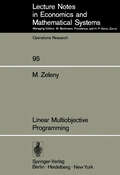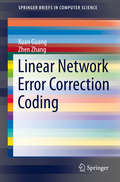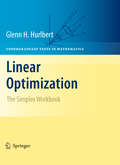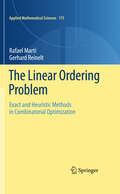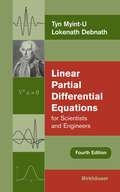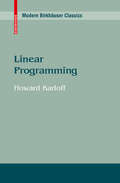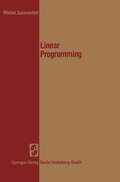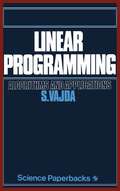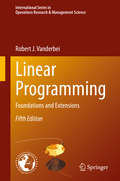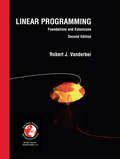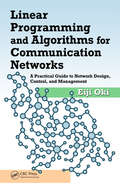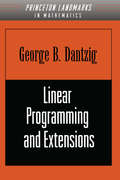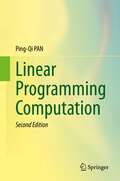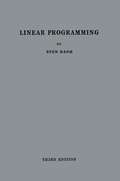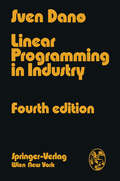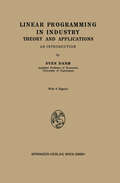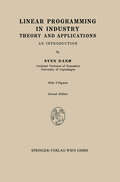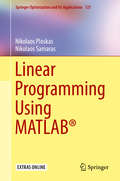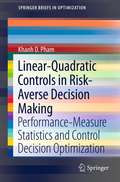- Table View
- List View
Linear Multiobjective Programming (Lecture Notes in Economics and Mathematical Systems #95)
by M. Zeleny1.1. The origin of the multiobjective problem and a short historical review The continuing search for a discovery of theories, tools and c- cepts applicable to decision-making processes has increased the complexity of problems eligible for analytical treatment. One of the more pertinent criticisms of current decision-making theory and practice is directed against the traditional approximation of multiple goal behavior of men and organizations by single, technically-convenient criterion. Reins- tementof the role of human judgment in more realistic, multiple goal se,ttings has been one of the ma~or recent developments in the literature. Consider the following simplified problem. There is a large number of people to be transported daily between two industrial areas and their adjacent residential areas. Given some budgetary and technological c- straints we would like to determine optimal transportation modes as well as the number of units of each to be scheduled for service. What is the optimal solution? Are we interested in the cheapest transportation? Do we want the fastest, the safest, the cleanest, the most profitable, the most durable? There are many criteria which are to be considered: travel times, consumer's cost, construction cost, operating cost, expected fatalities and injuries, probability of delays, etc.
Linear Network Error Correction Coding (SpringerBriefs in Computer Science)
by Xuan Guang Zhen ZhangThere are two main approaches in the theory of network error correction coding. In this SpringerBrief, the authors summarize some of the most important contributions following the classic approach, which represents messages by sequences similar to algebraic coding, and also briefly discuss the main results following the other approach, that uses the theory of rank metric codes for network error correction of representing messages by subspaces. This book starts by establishing the basic linear network error correction (LNEC) model and then characterizes two equivalent descriptions. Distances and weights are defined in order to characterize the discrepancy of these two vectors and to measure the seriousness of errors. Similar to classical error-correcting codes, the authors also apply the minimum distance decoding principle to LNEC codes at each sink node, but use distinct distances. For this decoding principle, it is shown that the minimum distance of a LNEC code at each sink node can fully characterize its error-detecting, error-correcting and erasure-error-correcting capabilities with respect to the sink node. In addition, some important and useful coding bounds in classical coding theory are generalized to linear network error correction coding, including the Hamming bound, the Gilbert-Varshamov bound and the Singleton bound. Several constructive algorithms of LNEC codes are presented, particularly for LNEC MDS codes, along with an analysis of their performance. Random linear network error correction coding is feasible for noncoherent networks with errors. Its performance is investigated by estimating upper bounds on some failure probabilities by analyzing the information transmission and error correction. Finally, the basic theory of subspace codes is introduced including the encoding and decoding principle as well as the channel model, the bounds on subspace codes, code construction and decoding algorithms.
Linear Optimization: The Simplex Workbook (Undergraduate Texts in Mathematics)
by Glenn HurlbertThe Subject A little explanation is in order for our choice of the title Linear Opti- 1 mization (and corresponding terminology) for what has traditionally been called Linear Programming.Theword programming in this context can be confusing and/or misleading to students. Linear programming problems are referred to as optimization problems but the general term linear p- gramming remains. This can cause people unfamiliar with the subject to think that it is about programming in the sense of writing computer code. It isn’t. This workbook is about the beautiful mathematics underlying the ideas of optimizing linear functions subject to linear constraints and the algorithms to solve such problems. In particular, much of what we d- cuss is the mathematics of Simplex Algorithm for solving such problems, developed by George Dantzig in the late 1940s. The word program in linear programming is a historical artifact. When Dantzig ?rstdevelopedthe Simplex Algorithm to solvewhat arenowcalled linear programming problems, his initial model was a class of resource - location problems to be solved for the U.S. Air Force. The decisions about theallocationswerecalled‘Programs’bytheAirForce,andhencetheterm.
The Linear Ordering Problem: Exact and Heuristic Methods in Combinatorial Optimization (Applied Mathematical Sciences #175)
by Rafael Martí Gerhard ReineltFaced with the challenge of solving the hard optimization problems that abound in the real world, existing methods often encounter great difficulties. Important applications in business, engineering or economics cannot be tackled by the techniques that have formed the predominant focus of academic research throughout the past three decades. Exact and heuristic approaches are dramatically changing our ability to solve problems of practical significance and are extending the frontier of problems that can be handled effectively. This monograph details state-of-the-art optimization methods, both exact and heuristic, for the LOP. The authors employ the LOP to illustrate contemporary optimization technologies as well as how to design successful implementations of exact and heuristic procedures. Therefore, they do not limit the scope of this book to the LOP, but on the contrary, provide the reader with the background and practical strategies in optimization to tackle different combinatorial problems.
Linear Partial Differential Equations for Scientists and Engineers
by Tyn Myint-U Lokenath DebnathThis significantly expanded fourth edition is designed as an introduction to the theory and applications of linear PDEs. The authors provide fundamental concepts, underlying principles, a wide range of applications, and various methods of solutions to PDEs. In addition to essential standard material on the subject, the book contains new material that is not usually covered in similar texts and reference books. It also contains a large number of worked examples and exercises dealing with problems in fluid mechanics, gas dynamics, optics, plasma physics, elasticity, biology, and chemistry; solutions are provided.
Linear Programming (Modern Birkhäuser Classics)
by Howard KarloffTo this reviewer’s knowledge, this is the first book accessible to the upper division undergraduate or beginning graduate student that surveys linear programming…. Style is informal. ...Recommended highly for acquisition, since it is not only a textbook, but can also be used for independent reading and study. —Choice Reviews This is a textbook intended for advanced undergraduate or graduate students. It contains both theory and computational practice. —Zentralblatt Math
Linear Programming: Algorithms and applications
by S. VajdaThis text is based on a course of about 16 hours lectures to students of mathematics, statistics, and/or operational research. It is intended to introduce readers to the very wide range of applicability of linear programming, covering problems of manage ment, administration, transportation and a number of other uses which are mentioned in their context. The emphasis is on numerical algorithms, which are illustrated by examples of such modest size that the solutions can be obtained using pen and paper. It is clear that these methods, if applied to larger problems, can also be carried out on automatic (electronic) computers. Commercially available computer packages are, in fact, mainly based on algorithms explained in this book. The author is convinced that the user of these algorithms ought to be knowledgeable about the underlying theory. Therefore this volume is not merely addressed to the practitioner, but also to the mathematician who is interested in relatively new developments in algebraic theory and in some combinatorial theory as well. The chapters on duality, and on flow in networks, are particularly directed towards this aim and they contain theorems which might not be directly relevant to methods of computation. The application of the concept of duality to the theory of games is of historical interest. It is hoped that the figures, which illustrate the results, will be found illuminating by readers with active geometrical imagination.
Linear Programming: Foundations and Extensions (International Series in Operations Research & Management Science #285)
by Robert J. VanderbeiThe book provides a broad introduction to both the theory and the application of optimization with a special emphasis on the elegance, importance, and usefulness of the parametric self-dual simplex method. The book assumes that a problem in “standard form,” is a problem with inequality constraints and nonnegative variables. The main new innovation to the book is the use of clickable links to the (newly updated) online app to help students do the trivial but tedious arithmetic when solving optimization problems.The latest edition now includes: a discussion of modern Machine Learning applications, as motivational material; a section explaining Gomory Cuts and an application of integer programming to solve Sudoku problems. Readers will discover a host of practical business applications as well as non-business applications. Topics are clearly developed with many numerical examples worked out in detail. Specific examples and concrete algorithms precede more abstract topics. With its focus on solving practical problems, the book features free C programs to implement the major algorithms covered, including the two-phase simplex method, the primal-dual simplex method, the path-following interior-point method, and and the homogeneous self-dual method. In addition, the author provides online tools that illustrate various pivot rules and variants of the simplex method, both for linear programming and for network flows. These C programs and online pivot tools can be found on the book's website. The website also includes new online instructional tools and exercises.
Linear Programming: Foundations and Extensions (International Series in Operations Research & Management Science #37)
by Robert J VanderbeiThis book provides an introduction to optimization. It details constrained optimization, beginning with a substantial treatment of linear programming and proceeding to convex analysis, network flows, integer programming, quadratic programming, and convex optimization. Coverage underscores the purpose of optimization: to solve practical problems on a computer. C programs that implement the major algorithms and JAVA tools are available online.
Linear Programming and Algorithms for Communication Networks: A Practical Guide to Network Design, Control, and Management
by Eiji OkiExplaining how to apply to mathematical programming to network design and control, Linear Programming and Algorithms for Communication Networks: A Practical Guide to Network Design, Control, and Management fills the gap between mathematical programming theory and its implementation in communication networks. From the basics all the way through to m
Linear Programming and Algorithms for Communication Networks: A Practical Guide to Network Design, Control, and Management
by Eiji OkiExplaining how to apply to mathematical programming to network design and control, Linear Programming and Algorithms for Communication Networks: A Practical Guide to Network Design, Control, and Management fills the gap between mathematical programming theory and its implementation in communication networks. From the basics all the way through to m
Linear Programming and Extensions
by George DantzigIn real-world problems related to finance, business, and management, mathematicians and economists frequently encounter optimization problems. In this classic book, George Dantzig looks at a wealth of examples and develops linear programming methods for their solutions. He begins by introducing the basic theory of linear inequalities and describes the powerful simplex method used to solve them. Treatments of the price concept, the transportation problem, and matrix methods are also given, and key mathematical concepts such as the properties of convex sets and linear vector spaces are covered. George Dantzig is properly acclaimed as the "father of linear programming." Linear programming is a mathematical technique used to optimize a situation. It can be used to minimize traffic congestion or to maximize the scheduling of airline flights. He formulated its basic theoretical model and discovered its underlying computational algorithm, the "simplex method," in a pathbreaking memorandum published by the United States Air Force in early 1948. Linear Programming and Extensions provides an extraordinary account of the subsequent development of his subject, including research in mathematical theory, computation, economic analysis, and applications to industrial problems. Dantzig first achieved success as a statistics graduate student at the University of California, Berkeley. One day he arrived for a class after it had begun, and assumed the two problems on the board were assigned for homework. When he handed in the solutions, he apologized to his professor, Jerzy Neyman, for their being late but explained that he had found the problems harder than usual. About six weeks later, Neyman excitedly told Dantzig, "I've just written an introduction to one of your papers. Read it so I can send it out right away for publication." Dantzig had no idea what he was talking about. He later learned that the "homework" problems had in fact been two famous unsolved problems in statistics.
Linear Programming Computation
by Ping-Qi PANThis monograph represents a historic breakthrough in the field of linear programming (LP)since George Dantzig first discovered the simplex method in 1947. Being both thoughtful and informative, it focuses on reflecting and promoting the state of the art by highlighting new achievements in LP. This new edition is organized in two volumes. The first volume addresses foundations of LP, including the geometry of feasible region, the simplex method and its implementation, duality and the dual simplex method, the primal-dual simplex method, sensitivity analysis and parametric LP, the generalized simplex method, the decomposition method, the interior-point method and integer LP method. The second volume mainly introduces contributions of the author himself, such as efficient primal/dual pivot rules, primal/dual Phase-I methods, reduced/D-reduced simplex methods, the generalized reduced simplex method, primal/dual deficient-basis methods, primal/dual face methods, a new decomposition principle, etc.Many important improvements were made in this edition. The first volume includes new results, such as the mixed two-phase simplex algorithm, dual elimination, fresh pricing scheme for reduced cost, bilevel LP models and intercepting of optimal solution set. In particular, the chapter Integer LP Method was rewritten with great gains of the objective cutting for new ILP solvers {\it controlled-cutting/branch} methods, as well as with an attractive implementation of the controlled-branch method. In the second volume, the `simplex feasible-point algorithm' was rewritten, and removed from the chapter Pivotal Interior-Point Method to form an independent chapter with the new title `Simplex Interior-Point Method', as it represents a class of efficient interior-point algorithms transformed from traditional simplex algorithms. The title of the original chapter was then changed to `Facial Interior-Point Method', as the remaining algorithms represent another class of efficient interior-point algorithms transformed from normal interior-point algorithms. Without exploiting sparsity, the original primal/dual face methods were implemented using Cholesky factorization. In order to deal with sparse computation, two new chapters discussing LU factorization were added to the second volume. The most exciting improvement came from the rediscovery of the reduced simplex method. In the first edition, the derivation of its prototype was presented in a chapter with the same title, and then converted into the so-called `improved' version in another chapter. Fortunately, the author recently found a quite concise new derivation, so he can now introduce the distinctive fresh simplex method in a single chapter. It is exciting that the reduced simplex method can be expected to be the best LP solver ever.With a focus on computation, the current edition contains many novel ideas, theories and methods, supported by solid numerical results. Being clear and succinct, its content reveals in a fresh manner, from simple to profound. In particular, a larger number of examples were worked out to demonstrate algorithms. This book is a rare work in LP and an indispensable tool for undergraduate and graduate students, teachers, practitioners, and researchers in LP and related fields.
Linear Programming in Industry: Theory and Applications. An Introduction
by Sven DanoThe present volume is intended to serve a twofold purpose. First, it provides a university text of Linear Programming for students of economics or operations research interested in the theory of production and cost and its practical applications; secondly, it is the author's hope that engineers, business executives, managers, and others responsible for the organization and planning of industrial operations may find the book useful as an introduction to Linear Programming methods and techniques. Despite the different backgrounds of these categories of potential readerR, their respective fields overlap to a considerable extent; both are concerned with economic optimization problems, and the use of Linear Programming to problems of production planning is simply applied theory of production. The non-economist reader may, but should not, pass over Chapter IV in which the linear production model is linked up with the economic theory of production. Without being an advanced text, the book aims at covering enough ground to make the reader capable of detecting, formulating, and solving such linear planning problems as he may encounter within his particular field. No heavy demands are made on the reader's mathematical profi ciency; except for the proofs in the Appendix-which may be skipped if desired-the mathematical exposition is purely elementary, involving only simple linear relations. In the author's experience, the pedagogical advantages of thi;:; approach, as compared with the use of matrix algebra, amply justify the sacrifice of mathematical elegance and typographical simplicity, particularly in explaining the simplex method.
Linear Programming in Industry: Theory and Applications An Introduction
by Sven DanoA. Planning Company Operations: The General Problem At more or less regular intervals, the management of an industrial enter prise is confronted with the problem of planning operations for a coming period. Within this category of management problems falls not only the overall planning of the company's aggregate production but problems of a more limited nature such as, for example, figuring the least-cost combina tion of raw materials for given output or the optimal transportation schedule. Any such problem of production planning is most rationally solved in two stages: (i) The first stage is to determine the feasible alternatives. For example, what alternative production schedules are at all compatible with the given capacity limitations? What combinations of raw materials satisfy the given quality specifications for the products? etc. The data required for solving this part of the problem are largely of a technological nature. (ii) The second is to select from among these alternatives one which is economically optimal: for example, the aggregate production programme which will lead to maximum profit, or the least-cost combination of raw materials. This is where the economist comes in; indeed, any economic problem is concerned with making a choice be.tween alternatives, using some criterion of optimal utilization of resources.
Linear Programming in Industry: Theory and Applications. An Introduction
by Sven DanoThe present volume is intended to serve a twofold purpose. First, it provides a university text of Linear Programming for students of or operations research interested in the theory of production economics and cost and its practical applications; secondly, it is the author's hope that engineers, business executives, managers, and others responsible for the organization and planning of industrial operations may find the book useful as an introduction to Linear Programming methods and techniques. Despite the different backgrounds of these categories of potential readers, their respective fields overlap to a considerable extent; both are concerned with economic optimization problems, and the use of Linear Programming to problems of production planning is simply applied theory of production. The non-economist reader may, but should not, pass over Chapter IV in which the linear production model is linked up with the economic theory of production. Without being an advanced text, the book aims at covering enough ground to make the reader capable of detecting, formulating, and solving such linear planning problems as he may encounter within his particular field. No heavy demands are made on the reader's mathematical profi ciency; except for the proofs in the Appendix-which may be skipped ü desired-the mathematical exposition is purely elementary, involving only simple linear relations. In the author's experience, the pedagogical advantages of this approach, as compared with the use of matrix algebra, amply justify the sacrilice of mathematical elegance and typographical simplicity, particularly in explaining the simplex method.
Linear Programming in Industry: Theory and Applications. An Introduction
by Sven DanoThe present volume is intended to serve a twofold purpose. First, it provides a university text of Linear Programming for students of .economics or operations research interested in the theory of production and cost and its practical applications; secondly, it is the author's hope that engineers, business executives, managers, and others responsible for the organization and planning of industrial operations may find the book useful as an introduction to Linear Programming methods and techniques. Despite the different backgrounds of these categories of potential readerft, their respective fields overlap to a considerable extent; both are concernE:'d with economic optimization problems, and the use of Linear Programming to problems of production planning is simply applied theory of production. The non-economist reader may, but should not, pass over Chapter IV in which the linear production model is linked up with the economic theory of production. Without bE:'ing an advanced text, the book aims at covering enough ground to make the reader capable of detecting, formulating, and solving such linear planning problems as he may encounter within his particular field. No heavy demands are made on the reader's mathematical profi ciency; except for the proofs in the Appendix-which may be skipped if desired-the mathematical exposition is purely elementary, involving only simple linear relations. In the author's experience, the pedagogical advantages of this approach, as compared with the use of matrix algebra, amply justify the sacrifice of mathematical elegance and typographical simplicity, particularly in explaining the simplex method.
Linear Programming Using MATLAB® (Springer Optimization and Its Applications #127)
by Nikolaos Ploskas Nikolaos SamarasThis book offers a theoretical and computational presentation of a variety of linear programming algorithms and methods with an emphasis on the revised simplex method and its components. A theoretical background and mathematical formulation is included for each algorithm as well as comprehensive numerical examples and corresponding MATLAB® code. The MATLAB® implementations presented in this book are sophisticated and allow users to find solutions to large-scale benchmark linear programs. Each algorithm is followed by a computational study on benchmark problems that analyze the computational behavior of the presented algorithms. As a solid companion to existing algorithmic-specific literature, this book will be useful to researchers, scientists, mathematical programmers, and students with a basic knowledge of linear algebra and calculus. The clear presentation enables the reader to understand and utilize all components of simplex-type methods, such as presolve techniques, scaling techniques, pivoting rules, basis update methods, and sensitivity analysis.
Linear-Quadratic Controls in Risk-Averse Decision Making: Performance-Measure Statistics and Control Decision Optimization (SpringerBriefs in Optimization)
by Khanh D. PhamLinear-Quadratic Controls in Risk-Averse Decision Making cuts across control engineering (control feedback and decision optimization) and statistics (post-design performance analysis) with a common theme: reliability increase seen from the responsive angle of incorporating and engineering multi-level performance robustness beyond the long-run average performance into control feedback design and decision making and complex dynamic systems from the start. This monograph provides a complete description of statistical optimal control (also known as cost-cumulant control) theory. In control problems and topics, emphasis is primarily placed on major developments attained and explicit connections between mathematical statistics of performance appraisals and decision and control optimization. Chapter summaries shed light on the relevance of developed results, which makes this monograph suitable for graduate-level lectures in applied mathematics and electrical engineering with systems-theoretic concentration, elective study or a reference for interested readers, researchers, and graduate students who are interested in theoretical constructs and design principles for stochastic controlled systems.
Linear Regression
by David J. OliveThis text covers both multiple linear regression and some experimental design models. The text uses the response plot to visualize the model and to detect outliers, does not assume that the error distribution has a known parametric distribution, develops prediction intervals that work when the error distribution is unknown, suggests bootstrap hypothesis tests that may be useful for inference after variable selection, and develops prediction regions and large sample theory for the multivariate linear regression model that has m response variables. A relationship between multivariate prediction regions and confidence regions provides a simple way to bootstrap confidence regions. These confidence regions often provide a practical method for testing hypotheses. There is also a chapter on generalized linear models and generalized additive models. There are many R functions to produce response and residual plots, to simulate prediction intervals and hypothesis tests, to detect outliers, and to choose response transformations for multiple linear regression or experimental design models.This text is for graduates and undergraduates with a strong mathematical background. The prerequisites for this text are linear algebra and a calculus based course in statistics.
Linear Systems
by Panos J. Antsaklis Anthony N. Michel"There are three words that characterize this work: thoroughness, completeness and clarity. The authors are congratulated for taking the time to write an excellent linear systems textbook!" —IEEE Transactions on Automatic Control Linear systems theory plays a broad and fundamental role in electrical, mechanical, chemical and aerospace engineering, communications, and signal processing. A thorough introduction to systems theory with emphasis on control is presented in this self-contained textbook, written for a challenging one-semester graduate course. A solutions manual is available to instructors upon adoption of the text. The book’s flexible coverage and self-contained presentation also make it an excellent reference guide or self-study manual. For a treatment of linear systems that focuses primarily on the time-invariant case using streamlined presentation of the material with less formal and more intuitive proofs, please see the authors’ companion book entitled A Linear Systems Primer.
Linear Time Series with MATLAB and OCTAVE (Statistics and Computing)
by Víctor GómezThis book presents an introduction to linear univariate and multivariate time series analysis, providing brief theoretical insights into each topic, and from the beginning illustrating the theory with software examples. As such, it quickly introduces readers to the peculiarities of each subject from both theoretical and the practical points of view. It also includes numerous examples and real-world applications that demonstrate how to handle different types of time series data. The associated software package, SSMMATLAB, is written in MATLAB and also runs on the free OCTAVE platform. The book focuses on linear time series models using a state space approach, with the Kalman filter and smoother as the main tools for model estimation, prediction and signal extraction. A chapter on state space models describes these tools and provides examples of their use with general state space models. Other topics discussed in the book include ARIMA; and transfer function and structural models; as well as signal extraction using the canonical decomposition in the univariate case, and VAR, VARMA, cointegrated VARMA, VARX, VARMAX, and multivariate structural models in the multivariate case. It also addresses spectral analysis, the use of fixed filters in a model-based approach, and automatic model identification procedures for ARIMA and transfer function models in the presence of outliers, interventions, complex seasonal patterns and other effects like Easter, trading day, etc. This book is intended for both students and researchers in various fields dealing with time series. The software provides numerous automatic procedures to handle common practical situations, but at the same time, readers with programming skills can write their own programs to deal with specific problems. Although the theoretical introduction to each topic is kept to a minimum, readers can consult the companion book ‘Multivariate Time Series With Linear State Space Structure’, by the same author, if they require more details.
Lineare Algebra für die Informatik: Vektorräume, Gleichungssysteme, Codierung, Quantenalgorithmen
by Kurt-Ulrich WittInternet, Soziale Netzwerke, Spiele, Smartphones, DVDs, digitaler Rundfunk und digitales Fernsehen funktionieren nur deshalb, weil zu ihrer Entwicklung und Anwendung mathematisch abgesicherte Verfahren zur Verfügung stehen. Dieses Buch vermittelt Einsichten in grundlegende Konzepte und Methoden der Linearen Algebra, auf denen diese Verfahren beruhen. Am Beispiel fehlertoleranter Codierung wird einführend gezeigt, wie diese Konzepte und Methoden in der Praxis eingesetzt werden, und am Beispiel von Quantenalgorithmen, die möglicherweise in Zukunft eine Rolle spielen, wird deutlich, dass die Lineare Algebra zeitinvariante Konzepte, Methoden und Verfahren bereitstellt, mit denen IT-Technologien konzipiert, implementiert, angewendet und weiterentwickelt werden können. Wegen seiner didaktischen Elemente wie Vorgabe von Lernzielen, Zusammenfassungen, Marginalien und einer Vielzahl von Übungen mit Musterlösungen eignet sich das Buch nicht nur als Begleitlektüre zu entsprechenden Informatik- und Mathematik-Lehrveranstaltungen, sondern insbesondere auch zum Selbststudium.
Lineare Algebra für Informatiker: I. Grundlagen, diskrete Mathematik. II. Lineare Algebra (Springer-Lehrbuch)
by Bodo PareigisDas vorliegende Buch bietet eine auf die Belange der mathematischen Grundausbildung der Informatiker zugeschnittene Einführung in die Lineare Algebra, die den Leser bis hin zu den Euklidischen Vektorräumen und der Hauptachsentransformation führt. Besonders interessant sind Anwendungen der Vektorrechnung in der Codierungstheorie, Anwendungen der Matrizenrechnung auf lineare Gleichungssysteme und elementare Rechenmethoden zur Invertierung und Zerlegung von Matrizen und zur Bestimmung von Eigenwerten. Dem Teil über Lineare Algebra geht ein breit angelegter Teil über Grundlagen der Mathematik und diskrete Mathematik voraus. Neben der Mengenlehre und der Einführung der Zahlen (mit einem Abschnitt über Rekursion) enthält das Buch Kapitel über Graphentheorie, algebraische Grundstrukturen (bis hin zum Rechnen in Booleschen Algebren), über Wahrscheinlichkeitsrechnung und eine Einführung in Fuzzy-Mengen. Mit vielen Beispielen und Anwendungen auch bestens zum Selbststudium geeignet.
